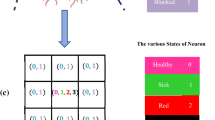Abstract
Alzheimer’s disease (AD) is a complex neurodegenerative disorder that leads to severe impairments in cognitive functions including memory and learning. An improved kinetic model is proposed here to understand the pathogenesis of AD in particular the role of glial cells in the presence of amyloid plaques and neurofibrillary tangles (NFTs). The kinetic model describes the production of activated microglia and astroglia. It involves two rate equations and incorporates the dual role of these glial cells which can function as neuroprotective and as neurotoxic cells. Examination of the steady state solutions of the model predicts an increase in population of these glial cells as (AD) progresses, and that this continues to increase linearly even after the amyloid population has reached a plateau.This is in agreement with experimental data. Limiting AD to the effect of amyloid peptides alone is incorrect and the role of neurofibrillary tangles, clearance rate of dead neurons and neuroinflammation from glial cells are vital and must be included in understanding the pathogenesis of AD. The study shows that increasing the clearance of dead neurons and use of any method to deactivate the glial cells will diminish the progression of AD.
Similar content being viewed by others
Data availabilty
No data was was used in this paper.
References
Abiega O, Beccari S, Diaz-Aparicio I, Nadjar A, Layé S et al (2016) Neuronal hyperactivity disturbs ATP microgradients, impairs microglial motility, and reduces phagocytic receptor expression triggering apoptosis/microglial phagocytosis uncoupling. PLOS Biol 14(5):e1002466
Abramov AY, Duchen MR (2005) The role of an astrocytic NADPH oxidase in the neurotoxicity of amyloid beta peptides. Philos Trans R Soc Lond B Biol Sci 360:2309–2314
Block ML, Zecca L, Hong JS (2007) Microglia-mediated neurotoxicity: uncovering the molecular mechanisms. Nat Rev Neurosci 8:57–69
De Caluwé J, Dupont G (2013) The progression towards Alzheimer’s disease described as a bistable switch arising from the positive loop between amyloids and Ca2+. J Theoret Biol 331:12–18
Dossi E, Vasile F, Rouach N (2018) Human astrocytes in the diseased brain. Brain Res Bull 136:139–156
Escartin C, Galea E, Lakatos A et al (2021) Reactive astrocyte nomenclature, definitions, and future directions. Nat Neurosci 24:312–325
Fakhoury M (2018) Microglia and astrocytes in Alzheimer’s disease: implications for therapy. Curr Neuropharmacol 16(5):508–518
Grathwohl SA, Kälin RE, Bolmont T, Prokop S, Winkelmann G, Kaeser SA, Odenthal J, Radde R, Eldh T, Gandy S et al (2009) Formation and maintenance of Alzheimer’s disease β-amyloid plaques in the absence of microglia. Nat Neurosci 12:1361–1363
Hynd MR, Scott HL, Dodd PR (2004) Glutamate-mediated excitotoxicity and neurodegeneration in Alzheimer’s disease. Neurochem Int 45:583–595
Kim YS, Jung HM, Yoo B (2018) Exploring glia to better understand Alzheimer’s disease. Anim Cells Syst (Seoul) 22(4):213–218
Li K, Li J, Zheng J, Qin S (2019) Reactive astrocytes in neurodegenerative diseases. Aging Dis 10(3):664–675
Liu CC, Zhao N, Fu Y, Wang N, Linares C, Tsai CW, Bu G (2017) Apoe4 accelerates early seeding of amyloid pathology. Neuron 96:1024–1032
Mizuno T, Doi Y, Mizoguchi H, Jin S, Noda M, Sonobe Y, Takeuchi H, Suzumura A (2011) Interleukin-34 selectively enhances the neuroprotective effects of microglia to attenuate oligomeric amyloid-β neurotoxicity. Am J Pathol 179:2016–2027
Neumann H, Kotter MR, Franklin RJM (2008) Debris clearance by microglia: an essential link between degeneration and regeneration. Brain 132:288–295
Overmyer M, Helisalmi S, Soininen H, Laakso M, RiekkinenSr P, Alafuzoff I (1999) Reactive microglia in aging and dementia: an immunohistochemical study of postmortem human brain tissue. Acta Neuropathol 97:383–392
Serrano-Pozo A, Mielke ML, Gomez-Isla T, Betensky RA, Growdon JH, Frosch MP, Hyman BT (2011) Reactive glia not only associates with plaques but also parallels tangles in Alzheimer’s disease. Am J Pathol 179:1373–1384
Serrano-Pozo A, Gomez-Isla T, Growdon JH, Frosch MP, Hyman BT (2013) A phenotypic change but not proliferation underlies glial responses in Alzheimer disease, majority of the glia responses observed in the AD brain. Am J Pathol 182(6):2332–2344
Sheffield LG, Marquis JG, Berman NE (2000) Regional distribution of cortical microglia parallels that of neurofibrillary tangles in Alzheimer’s disease. Neurosci Lett 285:165–168
Sheng JG, Mrak RE, Griffin WS (1997) Glial-neuronal interactions in Alzheimer disease: progressive association of IL-1α + microglia and S100β + astrocytes with neurofibrillary tangle stages. J Neuropathol Exp Neurol 56:285–290
Thurasisingham RA (2018) Pathogenesis of Alzheimer’s disease examined using a modified Puri-Li model that incorporates calcium ion homeostasis. J Mol Neuroscience 65(2):119–126
Thuraisingham RA (2017) Examining the role of microglia and astroglia during the pathogenesis of Alzheimer’s disease via the Puri-Li model. J Mol Neuroscience 62(3–4):363–387
Wang WY, Tan MS, Yu JT, Tan L (2015) Role of pro-inflammatory cytokines released from microglia in Alzheimer’s disease. Ann Transl Med 3(10):136–150
Wyss-Coray T, Loike JD, Brionne TC, Lu E, Anankov R, Yan F, Silverstein SC, Husemann J (2003) Adult mouse astrocytes degrade amyloid-β in vitro and in situ. Nat Med 9:453–457
Zhang Y, Wang W (2020) Mathematical analysis of stochastic model for Alzheimer’s disease. Commun Nonlinear Sci Numer Simulat 89:105347
Zilka N, Kazmerova Z, Jadhav S, Neradil P, Madan A, Obetkova D, Bugos O, Novak M (2012) Who fans the flames of Alzheimers’s disease brains? Misfolded tau on the crossroad of neurodegenerative and inflammatory pathways. J Neuroinflammation 9:47
Author information
Authors and Affiliations
Contributions
This work was carried out solely by the author. No other person was involved.
Corresponding author
Ethics declarations
Compliance with ethical standards
Not aplicable.
Consent to participate
No.
Consent for publication
Consent to publish as a subscrpition manuscript if accepted.
Conflict of interest
There are no conflicts of interest.
Additional information
Publisher’s note
Springer Nature remains neutral with regard to jurisdictional claims in published maps and institutional affiliations.
R. A. Thuraisingham is an honorary research fellow associated with the rehabilitation studies unit, Northern Clinical School University of Sydney, NSW 2065, Australia.
Rights and permissions
About this article
Cite this article
Thuraisingham, R.A. A kinetic scheme to examine the role of glial cells in the pathogenesis of Alzheimer’s disease. Metab Brain Dis 37, 801–805 (2022). https://doi.org/10.1007/s11011-022-00902-z
Received:
Accepted:
Published:
Issue Date:
DOI: https://doi.org/10.1007/s11011-022-00902-z




